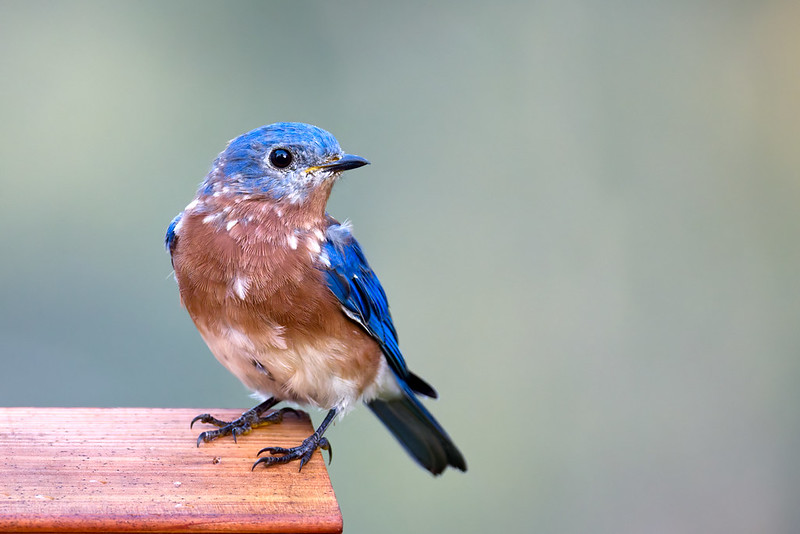I caught this Eastern Bluebird perched on the roof of a wooden birdhouse in my yard. You can see it’s in the middle of molting. The patchy white spots on the breast and the slightly ruffled plumage are clear signs of a bird replacing old feathers. This is a normal part of a bluebird’s yearly cycle.

Wildlife Notes: Understanding Eastern Bluebird Molt
Eastern Bluebirds (Sialia sialis) go through a complete prebasic molt once a year, usually from late summer into early fall. That’s exactly what I saw this October morning, an adult male mid-molt with new feathers growing in.
During molt, bluebirds shed and replace all their feathers in a set pattern. It begins with body feathers and then moves through the wings and tail. The white spotting on this bird’s breast isn’t part of its normal coloration. It’s the result of new feathers coming through or old ones missing. Once the molt is done, the bird will have a bright, fresh look again.
Adult males keep their vivid blue backs and orange breasts all year, but the colors appear richest after molt. This bird’s deep blue head and wings confirm that he’s an adult male, even in this in-between stage.
In Arkansas, bluebirds finish nesting by late summer, which gives them time to focus on feather renewal before colder weather. Molt uses a lot of energy, so birds avoid it when feeding young or migrating. They also stay closer to cover when their flight feathers are incomplete. The fact that this one perched comfortably on my birdhouse roof means it’s nearly finished molting and flying normally again.
Arkansas is part of the bluebird’s year-round range, so this bird will likely stay through the winter. Once his feathers are renewed, he’ll join small flocks searching for berries and insects.
You might also enjoy reading my related post, Early Fall Eastern Bluebird Activity at the Birdhouse, which shows how these birds behave around my yard this time of year.
Photography Notes: Capturing Birds During Molt
Photographing birds in molt can be tricky. Their uneven feathers might not seem ideal for portraits, but they tell an honest story about bird life.
I took this photo at 7:42 a.m. on October 1 under overcast skies. The soft, even light brought out the subtle texture of the feathers. The blurred background kept all attention on the bird and the birdhouse roof.
Camera Settings:
- Canon EOS R5
- Canon RF 200–800mm f/6.3–9 IS USM at 600mm
- f/8
- 1/500 second
- ISO 5000
- Exposure Compensation: 0
Early light is dim, so ISO 5000 gave me a fast enough shutter speed to freeze motion. The R5 handled the noise well, and fine feather detail stayed crisp. Shooting at f/8 provided enough depth of field to keep the head and body sharp while keeping the background smooth.
The RF 200–800mm lens handled beautifully. Image stabilization made hand-holding easy, and autofocus locked right on the bird’s eye. For composition, I placed the bluebird slightly off-center, following the rule of thirds. Facing the bird into the frame added balance and space for context. The wooden roof added a natural touch without distraction.
Whenever I photograph birds with mixed plumage tones, I check the histogram to ensure highlights and shadows are balanced. The R5’s dynamic range did a great job with the contrast between the bird’s blue and rust-colored feathers.
